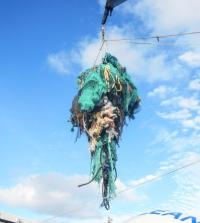
Ghost nets — Photo: The Ocean Cleanup
A new study published in Nature suggests that the Great Pacific Garbage Patch is growing “exponentially” and now spans roughly 617,763 square miles (1.6 million square km), or about three times the size of France. The garbage patch is an accumulation of plastic and floating debris brought together by a gyre, a circular current, in the Pacific between California and Hawaii. It is thought to be the largest ocean garbage patch on earth. According to the new study, the trash is made up of 1.8 trillion pieces of plastic weighing nearly 90,000 tons. This new estimate is between four and sixteen times greater than had previously been predicted.
One aspect of the study that appears to have drawn less attention than the size and the extent of the patch is what it is made of. The study determined that at least 46% of the floating debris are fishing nets and related cordage. These “ghost nets” are a major threat to fish populations around the world and pose an entirely different set of challenges in any potential cleanup.
The problem of ghost nets may be significantly larger than even the Great Pacific Garbage Patch. The conservation group World Animal Protection estimates that around 640,000 tonnes of so-called ‘ghost gear’ is left in oceans each year. This ghost gear continues to catch and kill fish and animals as large as whales. The International Whaling Commission estimates that 308,000 whales and dolphins die annually due to entanglement in fishing gear, and more still in marine debris.
The Great Pacific Garbage Patch – Explainer
Thanks to David Rye for contributing to this post.

I could understand this happening in the Atlantic as states like New York still has barges that dump their trash in the ocean. Yet it is my understanding the West coast doesnt have this practice. So where is the trash coming from. Granted some came from the tsunami that struck Japan as well as fishing fleets. Yet that plastic dump is getting larger so some one is still contributing on a massive scale.
Maybe its time fishing vessels should go back to hemp, sisal and other natural fibers for making nets. Stuff that wont take for ever to decompose.
Congress outlawed ocean dumping back in the 80’s
@Willy bruddah, New York stopped ocean dumping 25 years ago.
Like the article says, most of it is fishing nets. Also, you know, not all the trash comes from the US. Many Pacific rim countries don’t really have waste management systems.